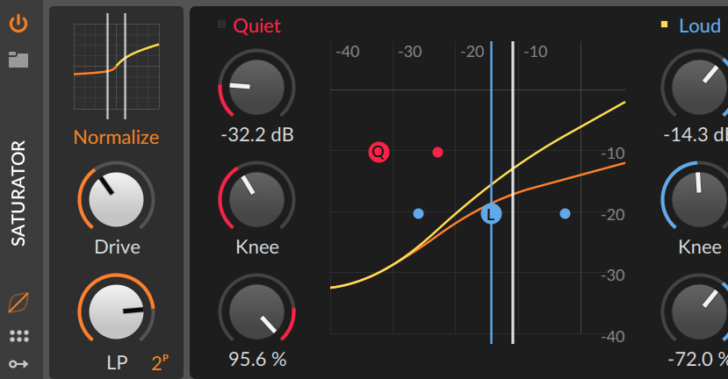Bitwig has released Bitwig Studio 3.2, an update that focuses on greater control and sculpting possibilities for all sounds, whether coloring audio sources or reinterpreting note messages in new and adventurous ways.
Here’s what’s new in Bitwig Studio 3.2:
EQ+ – Along with 14 filter options and up to eight bands, EQ+ also has an Adaptive-Q option to narrow the width of bands as their gain increases, in addition to global frequency Shift and Gain controls, “soloing” a band while dragging it for precise editing, and different oversampling modes. Sculpting a sound is now more like drawing the spectrum than twiddling knobs.
Saturator – Bitwig Studio’s new Saturator is a unique waveshaper that works in the log domain, just like our ears. Bitwig says that, with Saturator, richness can be added to any sound in just the right places.
Arpeggiator has added a number of features and possibilities. Along with controls for velocity and note length, each step now has a pitch control which functions like step sequencing new patterns on top of the notes being held. And for those using MPE-enabled or other advanced controllers, micro-pitch changes are now tracked, and per-note pressure messages will update note velocities for more dynamic performances.
Note FX Selector and audio FX Selector have all gained voice modes, for dynamically triggering different layers. Whether each note of a chord needs a slightly different preset or a totally different VST, these modes will handle the details without any fuss. The same is true for a few arpeggiators set to do polyrhythms or a pile of audio effects that should be swept through.
Keyswitches turns a range of notes into controls that target specific layers (good for film scoring with different sounds and articulations).
CC mode uses any control change message to sweep through the available layers (like using mod wheel to cycle through various note FX), and Program Change does the same with those kinds of MIDI messages (common from pedal controllers, etc.).
Note Delay waits up to two bars (or five seconds) before passing notes to a layer. On the modulation level, the ADSR, AHDSR, and Note Sidechain modulators all have similar Pre-delay controls now. And within The Grid, the start or release of signals can now be suspended with the Logic Delay module. In addition, the new AHD on Release modulator animates any parameter note release for instant responsiveness. Sum it up, and creating growing sonic landscapes has been made simple on every level.
In addition, the update delivers workflow enhancements, updates to Grid modules and more.
Availability
Bitwig Studio 3.2 is now available. It is available to download for anyone with an active Upgrade Plan for Bitwig Studio. Bitwig Studio 16-Track and Bitwig Studio 8-Track will also get updated, but the new devices are available only in the full version of Bitwig Studio. See the Bitwig site for details.


Another great update, one of the most advanced and fun music production tools available, great job but a small development team (just 5 people) producing updates like this every 4 months,
If you haven’t tried bitwig for a while, give it a go, 100 bucks off at the moment to boot. Even if you have a DAW yiu are happy with the GRID and unified modulation system make Bitwig a very powerful modular synth for sound design. It may have been based on many concepts from Live when it launched four or five years ago, but it has taken many concepts like racks to the next level and has become one of the main innovators in the DAW world….EQ may be the best EQ I have seen integrated in any DAW.
seems like Bitwig is really ramping up the speed on updates these days
im ready to buy it
Purchased yesterday. This article doesn’t mention that it is at a great sale price right now. Even cheaper at jrrshop than at Bitwig’s site.
thank you Frank!
hey bitwig,
meh. how about this?
“You can extract grooves from audio clips in the same way as from MIDI clips: drag them to the Groove Pool or directly on top of another MIDI or audio clip. In this case, the audio clip’s Transient markers are converted to MIDI notes in the resulting groove file, and the audio level of those transients determines the velocity of the MIDI notes in the groove clip.”
these are basics. this is essential. i won´t switch from live to you unless you come up with a groove extraction tool.
yes, they rise fairly quickly. modulators and the grid are really well integrated. watch out ableton.